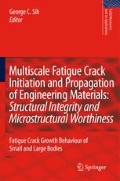Fracture toughness and fatigue crack growth rate data are two key parameters which are necessary for conducting safe life analysis of fracture critical parts used in space and aircraft structures. Currently, these allowables are obtained through the ASTM testing standards which are costly and time consuming. In many occasions, due to budget limitations and deadlines set forth by the customer, it is not possible to conduct fracture related tests in time. A proposed numerical approach has been developed [1–3] that is based on the extended Griffith theory and can predict fracture allowables for a variety of alloys. The simplicity of the concept is based on the use of basic, and in most cases available, uniaxial full stress-strain data to derive material fracture toughness values. Because the fracture toughness is thickness dependent, its value for several thicknesses can be calculated and used in the residual strength capability analysis. More importantly, its value is used to predict the region III of the fatigue crack growth rate curve. Regions I & II of the da/dN versus ΔK curve can be estimated separately and will be connected to region III to establish the total fatigue crack growth rate data. As the result of this work two computer codes, fracture toughness determination (FTD) and fatigue crack growth (FCG), were generated under the NASA contract. Results of fracture toughness and fatigue crack growth rate data calculated by this approach were compared with numerous test data in the NASGRO database [4]. Excellent agreements between analyses and test data were found, which will validate the FTD and FCG methodology. This novel approach is referred to as the virtual testing technique. It enables engineers to generate fracture allowable analytically by eliminating unnecessary tests. Yet, there is another innovative approach in the virtual testing arena that relies on the multiscale modeling and simulation technique. This technique is becoming popular in the field of computational materials, where failure mechanism is defined from the bottom up approach. The methodology is based on the ab-initio concept where it is assumed that the failure of material will initiate from the atomistic level, where nanocracks under the applied load will grow (as the result of poor bonding) and advance toward the micro, meso, and macro level, which thereafter will cause total structural failure. It should be noted that in most cases microscopic cracks already pre-existed in the part during the machining operation, assembling parts, or rough handling. Section 6 will briefly review the application of multiscale modeling and simulation technique and its application on aerospace and aircraft parts.
Access this chapter
Tax calculation will be finalised at checkout
Purchases are for personal use only
Preview
Unable to display preview. Download preview PDF.
Author information
Authors and Affiliations
Editor information
Editors and Affiliations
Rights and permissions
Copyright information
© 2008 Springer Science+Business Media B.V
About this paper
Cite this paper
Farahmand, B. (2008). Application of Virtual Testing for Obtaining Fracture Allowable of Aerospace and Aircraft Materials. In: Sih, G.C. (eds) Multiscale Fatigue Crack Initiation and Propagation of Engineering Materials: Structural Integrity and Microstructural Worthiness. Solid Mechanics and its Applications, vol 152. Springer, Dordrecht. https://doi.org/10.1007/978-1-4020-8520-8_1
Download citation
DOI: https://doi.org/10.1007/978-1-4020-8520-8_1
Publisher Name: Springer, Dordrecht
Print ISBN: 978-1-4020-8519-2
Online ISBN: 978-1-4020-8520-8
eBook Packages: EngineeringEngineering (R0)

